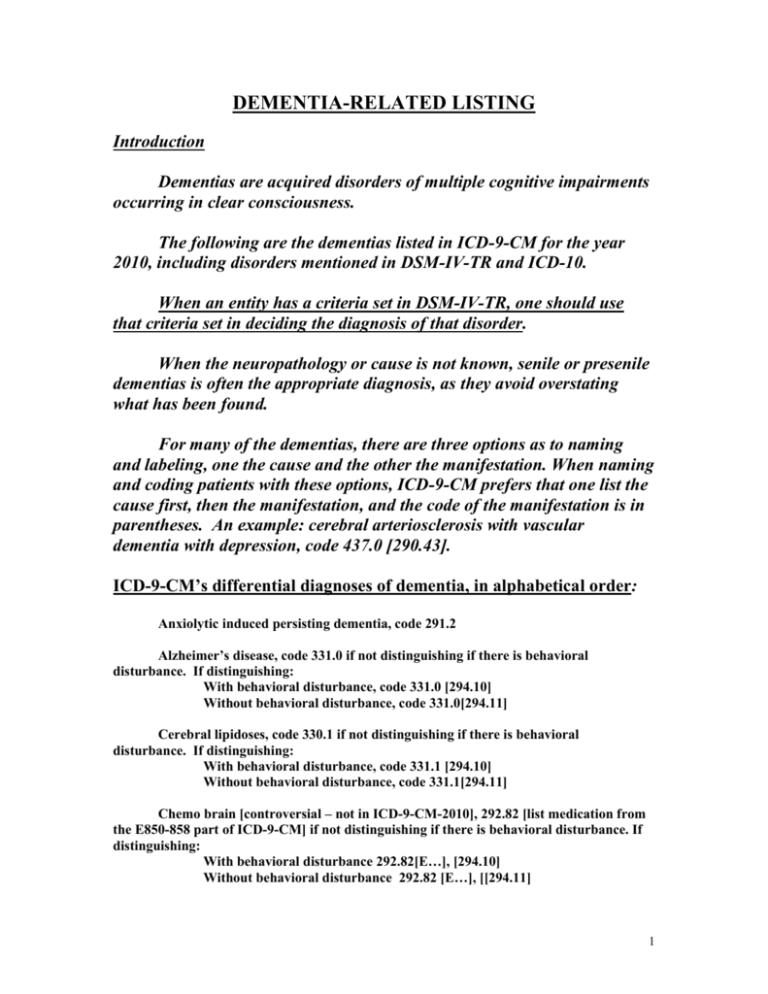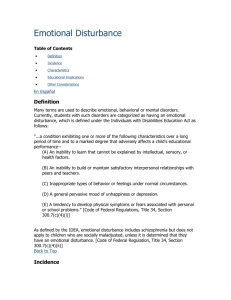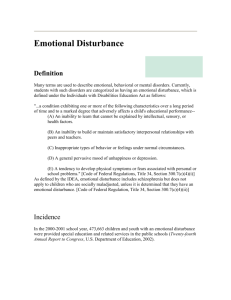DEMENTIA-RELATED LISTING
advertisement

DEMENTIA-RELATED LISTING Introduction Dementias are acquired disorders of multiple cognitive impairments occurring in clear consciousness. The following are the dementias listed in ICD-9-CM for the year 2010, including disorders mentioned in DSM-IV-TR and ICD-10. When an entity has a criteria set in DSM-IV-TR, one should use that criteria set in deciding the diagnosis of that disorder. When the neuropathology or cause is not known, senile or presenile dementias is often the appropriate diagnosis, as they avoid overstating what has been found. For many of the dementias, there are three options as to naming and labeling, one the cause and the other the manifestation. When naming and coding patients with these options, ICD-9-CM prefers that one list the cause first, then the manifestation, and the code of the manifestation is in parentheses. An example: cerebral arteriosclerosis with vascular dementia with depression, code 437.0 [290.43]. ICD-9-CM’s differential diagnoses of dementia, in alphabetical order: Anxiolytic induced persisting dementia, code 291.2 Alzheimer’s disease, code 331.0 if not distinguishing if there is behavioral disturbance. If distinguishing: With behavioral disturbance, code 331.0 [294.10] Without behavioral disturbance, code 331.0[294.11] Cerebral lipidoses, code 330.1 if not distinguishing if there is behavioral disturbance. If distinguishing: With behavioral disturbance, code 331.1 [294.10] Without behavioral disturbance, code 331.1[294.11] Chemo brain [controversial – not in ICD-9-CM-2010], 292.82 [list medication from the E850-858 part of ICD-9-CM] if not distinguishing if there is behavioral disturbance. If distinguishing: With behavioral disturbance 292.82[E…], [294.10] Without behavioral disturbance 292.82 [E…], [[294.11] 1 Chronic traumatic encephalopathy [not specifically listed in ICD-9-CM-2010], code 310.2 if not distinguishing if there is behavioral disturbance. If distinguishing: With behavioral disturbance, code 310.2 [294.10] Without behavioral disturbance, code 310.2 [294.11] Creutzfeldt-Jakob disease, code 046.1 if not distinguishing if there is behavioral disturbance. If distinguishing: With behavioral disturbance, code 046.1[294.10] Without behavioral disturbance, code 046.1[294.11] Drug-induced persisting dementia, code 292.82 For these disorders, list drug when known, e.g. E851 Barbiturates E852.2 bromine compounds E855.4 Anticholinergics E858.8 Other specific medications. Example, “E858.8 tamoxifen” Dementia associated with head trauma, code 850 for the head trauma and 294.8 for the dementia, so: Head trauma with dementia 850[294.8]. Dementia associated with Lewy bodies, code 331.82 if not distinguishing if there is behavioral disturbance. If distinguishing: With behavioral disturbance, code 331.82[294.10] Without behavioral disturbance, code 331.82[294.11] Dementia pugilistica [not specifically in ICD-9-CM-2101], code 310.2 if not distinguishing if there is behavioral disturbance. If distinguishing: With behavioral disturbance, code 310.2 [294.10] Without behavioral disturbance, code 310.2 [294.11] Epilepsy associated with dementia. Some of the major epilepsies listed in ICD-9-CM are generalized convulsive, code 345.1 and generalized non-convulsive epilepsy, 345.0. So, four of the common choices are: With behavioral disturbance, code 345.1/345.0[294.10] Without behavioral disturbance, code 345.1/345.0[294.11] For example; Generalized convulsive disorder without behavioral disturbance: 345.1[294.11] Folic-acid deficiency associated with dementia: With behavioral disturbance, code 266.2[294.10] Without behavioral disturbance, code 266.2[294.11] Frontal dementia, code 331.19 if not distinguishing if there is behavioral disturbance. If distinguishing: With behavioral disturbance, code 331.19[294.10] Without behavioral disturbance, code 331.19[294.11] Frontotemporal dementia, code 331.19 if not distinguishing if there is behavioral disturbance. If distinguishing: 2 With behavioral disturbance, code 331.82[294.10] Without behavioral disturbance, code 331.82[294.11] General paresis, code 094.1, if not distinguishing if there is behavioral disturbance. If distinguishing: With behavioral disturbance, code 094.1[294.10] Without behavioral disturbance, code 094.1[294.11] Hepatolenticular degeneration [Wilson’s Disease], code 275.1 if not distinguishing if there is behavioral disturbance. If distinguishing: With behavioral disturbance, code 275.1[294.10] Without behavioral disturbance, code 275.1[294.11] HIV Disease: With behavioral disturbance, code 042[294.10] Without behavioral disturbance, code 042[294.11] Hypercalcemia associated with dementia, With behavioral disturbance, code 275.42[294.10] Without behavioral disturbance, code 275.42[294.11] Hypothyroidism associated with dementia, With behavioral disturbance, code 244.9[294.10] Without behavioral disturbance, code 244.9[294.11] Huntington’s disease, code 333.4, if not distinguishing if there is behavioral disturbance. If distinguishing: With behavioral disturbance, code 331.4[294.10] Without behavioral disturbance, code 331.4[294.11] Hydrocephalus, three choices as to the hydrocephalus per se: Communicating hydrocephalus, code 331.3 Obstructive hydrocephalus, code 331.4. Idiopathic normal pressure hydrocephalus, code 331.5 Then, the need to explicate the dementia has the following codes: Dementia with behavioral disturbance, code 331.3/331.4/331.5[294.10] Dementia without behavioral disturbance, code 331.3/331.4/331.5[294.11] Jakob-Creutzfeldt disease, With behavioral disturbance, code 046.1[294.10] Without behavioral disturbance, code 046.1[294.11] Multiple sclerosis with dementia: Dementia with behavioral disturbance, code 340[294.10] Dementia without behavioral disturbance, code 340[294.11] Niacin deficiency associated with dementia [pellagra]: 3 With behavioral disturbance, code 265.2[294.10] Without behavioral disturbance, code 265.2[294.11] Parkinsonism associated with dementia, With behavioral disturbance, code 331.82[294.10] Without behavioral disturbance, code 331.82[294.11] Pick’s disease, code 331.11, if not distinguishing if there is behavioral disturbance. If distinguishing: With behavioral disturbance, code 331.11[294.10] Without behavioral disturbance, code 331.11[294.11] Polyarteritis nodosa, code 446.0, if not distinguishing if there is behavioral disturbance. If distinguishing: With behavioral disturbance, code 446.0[294.10] Without behavioral disturbance, code 446.0[294.11] Presenile dementia [use when onset is < 65 y/o] With delirium, code 290.11 With delusional features, code 290.12 With depressive features, code 290.13 Uncomplicated, code 290.10 [This is used when the dementia does not feature delirium, delusions or depression.] Senile dementia [see “presenile” supra when onset is before 65 y/o] With delusional features, code 290.20 With depressive features, code 290.21 With delirium, code 290.3 Uncomplicated, code 290.0 [This is used when the dementia does not feature delirium, delusions or depression.] Systemic lupus erythematosus associated with dementia: With behavioral disturbance, code 710.0[294.10] Without behavioral disturbance, code 710.0[294.11] Trypanosomiasis [Chagas’s disease] associated with dementia: With behavioral disturbance, code 086.9[294.10] Without behavioral disturbance, code 086.9[294.11] Vascular dementia With delirium, code 290.41 With delusions, code 290.42 With depression, code 290.43 Uncomplicated, code 290.40 [This is used when the dementia does not feature delirium, delusions or depression.] If important also to state that the patient has cerebral arteriosclerosis, which is contributing to the vascular dementia, then code 437.0. For example: cerebral arteriosclerosis with vascular dementia with depression, code 437.0 [290.43]. If it is important also to state that the patient also has cerebral thrombosis, then one can use cerebral thrombosis with cerebral infarction, code 434.01, or cerebral thrombosis without cerebral infarction, code 434.00. 4 If it is important also to state that the patient has cerebral embolism with cerebral infarction, code 434.11, or cerebral embolism without cerebral infarction, code 434.10 For dementias not listed above: Dementia, Other 294.8. For dementias that are unspecified, use Presenile or Senile Dementia depending on age of onset. Non-dementia diagnoses that may meet a need when the dementia dx is not appropriate: Altered mental state, code 780.97 Change in mental status, code 780.97 Cognitive deficits following late effects of cerebral hemorrhage or infarction Cognitive impairment due to intracranial or head injury, 959.01 if it is not necessary to be specific to the type of injury [If necessary, ICD-9-CM-2010 has 27 specific codes from 850.11 to 854.1] Cognitive impairment due to late effects of intracranial injury, 907 Late effects of cerebrovascular disease, cognitive deficits, code 438.0 Mild cognitive impairment, 331.83 Mild memory disturbance, 310.8 Personality change, non-psychotic, 310.1 Postconcussion syndrome, 310.2. [ICD-9-CM definition: Nonpsychotic disorder due to brain trauma, causes symptoms unrelated to any disease process; symptoms include amnesia, serial headaches, rapid heartbeat, fatigue, disruptive sleep pattern, inability to concentrate.] Transient cerebral ischemia, then code by syndrome: Basilar artery syndrome, code 435.0 Subclavian steal syndrome, code 435.2 Vertebral artery syndrome, code 435.1 Vertebrobasilar artery syndrome, code 435.3 Unspecified transient cerebral ischemia, code 435.9 Transient global amnesia, code 437.7 [ICD-9-CM-2010 definition: “Episodes of short-term memory loss, not often recurrent, pathogenesis unknown, with no signs of symptoms of neurological disorder.”] 5 6







